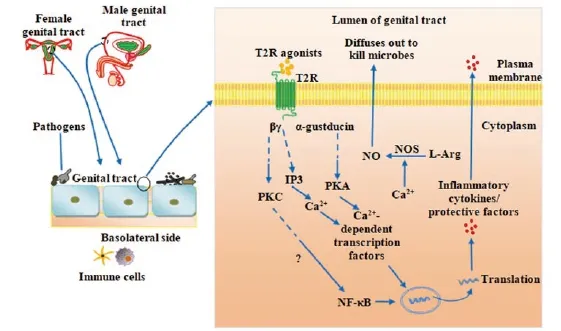Bitter taste receptor agonists to abate the bitterness of genital infections: A hype or hope?
2020-04-08MenizibeyaWelcome
Menizibeya O. Welcome
Department of Physiology, Faculty of Basic Medical Sciences, Nile University of Nigeria, Abuja, Nigeria
Dear Editor,
Genital infections are associated with high level of morbidity,economic and psychosocial burden. Several millions of new cases are reported annually among people aged 15-49 years. The complications of genital infections include chronic neurological diseases, end stage renal disease in adults, ectopic pregnancy,premature delivery and stillbirth[1]. Indeed, genital infections account for about 15%-35% and 50%-75% of infertility cases in males and females respectively[2]. Despite the awareness campaign and substantial improvement in medical treatment, the incidence of genital infections has continued to increase over the past years.Without doubt, this negative trend corroborates the necessity to search for alternative areas that may lead to discovery of novel therapy for genital infections.
Bitter taste receptors (T2Rs), first discovered in the gastrointestinal tract, are now believed to be widely expressed in several cells and tissues of the body where they play diverse roles in sensing toxins and also serve as immune sentinels. Recently, T2R expression was reported in cells, tissues and organs of the genital system:cervix, vagina, endometrium, myometrium, placenta, ovary,prostate, testis, and spermatozoa[3,4]. T2Rs are transmembrane G protein-coupled receptors that sense bitter compounds by activatingα- gustducin, which signals downstream cell, mediating responses that subsequently lead to the activation of defense mechanisms, which are aimed at abating the pathogenic aggression.This is why T2Rs are now referred to as critical components of the sensory and immune system. To date, twenty five subtypes of human T2Rs have been discovered. T2Rs are activated by bitter molecules including caffeine, amarogentin, and denatonium.There are currently more than 1 000 known bitter compounds[5]and numerous naturally occurring ones mainly derived from plant sources[6]. These T2R agonists present potential application in drug discovery and therapeutics of genital infections.
In the genital tract, T2Rs are readily activated by the microbial compounds - quorum sensing signal molecules, produced by bacteria (Gram-positive and Gram-negative), parasites, and virus to regulate biofilm formation, motility and virulence[7,8].Interestingly, about 50% of the microbial genome and 80%of microbial motility are regulated by quorum sensing signal molecules. Examples of quorum sensing signal molecules include α- hydroxyketones, acyl homoserine lactones, alkylquinolones,autoinducers, autoinducing peptides, and diffusible signal factors,among others[8]. The SigMol database contains all currently known quorum sensing signal molecules[8].
The T2Rs regulate microbial aggression in the genital tract by actively interacting with bitter molecules and products of microbial pathogens, and perhaps with the genital microflora. Consequently,the genital T2Rs act as immune sentinels by mediating cellular responses and activating protective mechanisms against pathogenic aggression in the genital system[3,4].
The expressions of T2Rs in genital epithelial cells and spermatozoa suggest a role of these receptors in sensing the genital fluidic milieu for harmful and pathogenic components to mobilize responses against genital infections[3]. Importantly, T2R signaling disorders in spermatozoa were reportedly associated with multiple damages caused byPseudomonas aeruginosa[7].Truly, data demonstrate that genital T2Rs detect not only bitter compounds but also the uropathogenicEscherichia colito initiate cellular and tissue responses that prevent the colonization of the genital tract by pathogens[9]. The presence of T2Rs in the endometrium and myometrium suggests their possible roles in the pathogenesis of endometritis and myometritis respectively. For example, Zhenget alreported that the T2R agonist, chloroquine,prevented bacterial lipopolysaccharide-induced endometritis,myometritis, chorioamnionitis and villitis in pregnant experimental animals[10]. These findings indicate a critical role of T2Rs in the pathophysiology of preterm labor and stillbirth induced by uterine infections. Thus, the placental T2Rs not only prevent harmful substances from getting to the conceptus, but also play a critical role in inflammatory processes occurring in the placenta. A schematic representation of bitter taste receptor responses to agonist stimulation in the genital tract is depicted in Figure 1.

Figure 1. Schematic representation of bitter taste receptor signaling in the genital tract. T2Rs: bitter taste receptors; IP3: inositol triphosphate; PKC: protein kinase C; PKA: protein kinase A; NO: nitric oxide; NOS: nitric oxide synthase; L-Arg: L-arginine; NF-κB: nuclear factor kappa B.
From the emerging evidence presented above, it can be summarized that effective detection of bitter compounds or pathogenic products by T2Rs constitutes a critical mechanism in the prevention of genital tract infections. Since the mechanisms of quorum sensing are actively been researched for novel antimicrobial therapy to the control resistant microbial species[7,8], research crusade aimed at investigating the signaling pathways of genital T2Rs can lead to identification of key molecular targets for novel therapeutics of genital infections. Thus, there is a need to step up investigations on the molecular mechanisms of T2R sensing of the “quorum” and“suppression of pathogenic aggression” in the genital tract for novel medical application.
Conflict of interest statement
There is no conflict of interest regarding the publication of this paper.
Author’s contributions
Menizibeya O. Welcome wrote the paper.
杂志排行
Asian Pacific Journal of Reproduction的其它文章
- Erectile dysfunction and statins: The assorted view of preponderance
- Effect of routine iron supplementation on copper level and oxidative stress status in pregnant women
- Effect of short-term gavage of ethanolic extract of cogon grass (Imperata cylindrica L)root on the ovarian activity and estrus behavior of female mice
- Effect of aqueous seed extract of Mucuna pruriens on arsenic-induced testicular toxicity in mice
- Effects of ciprofloxacin on testicular tissue and sperm quality in rabbits
- Influence of N-acetylcysteine on pituitary-gonadal axis hormones and protamine expression level in streptozotocin-induced diabetic male rats
